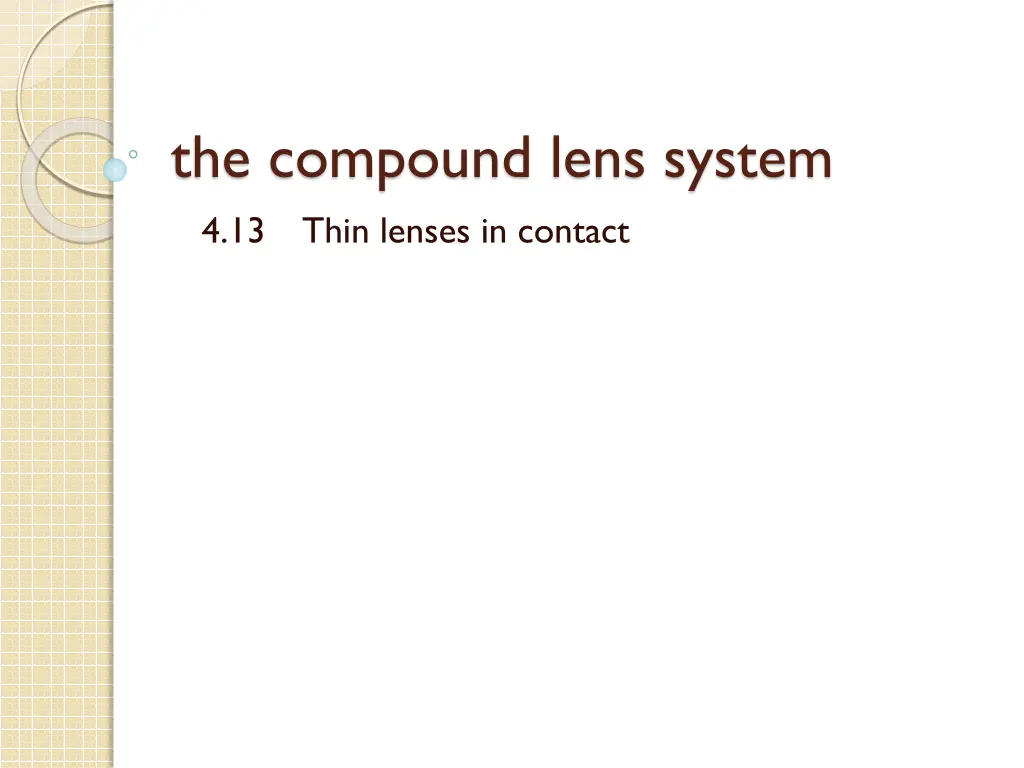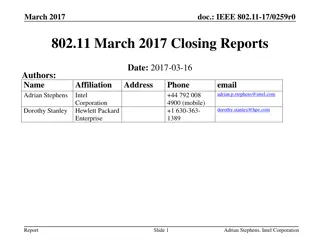
Understanding Compound Lens Systems and Focal Lengths
Explore the concept of compound lens systems, focal lengths, and the effects of placing multiple lenses in contact. Learn how to calculate front and back focal lengths in a compound lens setup and understand transverse magnification. Dive into practical scenarios involving thin lenses separated by distances shorter than their focal lengths.
Download Presentation

Please find below an Image/Link to download the presentation.
The content on the website is provided AS IS for your information and personal use only. It may not be sold, licensed, or shared on other websites without obtaining consent from the author. If you encounter any issues during the download, it is possible that the publisher has removed the file from their server.
You are allowed to download the files provided on this website for personal or commercial use, subject to the condition that they are used lawfully. All files are the property of their respective owners.
The content on the website is provided AS IS for your information and personal use only. It may not be sold, licensed, or shared on other websites without obtaining consent from the author.
E N D
Presentation Transcript
the compound lens system 4.13 Thin lenses in contact
(a) The effect of placing a second lens L2within the focal length of a positive lens L1. (b) when L2is positive, its presence adds convergence to the bundle of rays. (c) When L2is negative, it adds divergence to the bundle of rays.
Two thin lenses separated by a distance smaller than either focal length
Q13:Imagin a compound lens consisting of thin positive lens followed at an interval of 20 cm by a thin negative lens. If these have focal length of 40 cm and -40 cm respectively ,determine the front focal length and the back focal length?
solution 40[20 40 )] 20 [40+ 40 ]= 120 ?? =?.?.? = From the previous slide, we calculated si2. Therefore, if so1 we get, ?.?.? = ? (?1+?2)= ?2(? ?1) 40(20 40) 20 [40+ 40 ] = 40 cm
Note that d > si1, so that the object for Lens 2 (L2) is real. For the compound lens system, so1is the object distance and si2is the image distance. 1 s 1 f 1 s s f = = 1 1 , o s 1 i s f 1 1 1 1 1 i o o 0 ( ) s virtual 2 o = s d s 2 1 o i 0 ( ) s real 2 o f s f f d 2 1 1 o ( d ) 2 1 s 1 f 1 s f d s f s f = = = = 2 2 f 1 2 1 1 , o i o s ( ) 2 i s f s s s f d f 1 1 o 2 2 2 2 2 1 2 i o o i 2 s f 1 1 o The total transverse magnification (MT) is given by s s f s = = = 1 2 1 f 2 i i i M M M ( ) 1 2 T T T s s d s s f 1 2 1 1 1 1 o o o o
Q12: A compound lens consists of two thin-bi-convex lenses L1and L2of focal lengths 10 cm and 20 cm , separated by a distance of 80 cm. describe the mage corresponding to a 5 cm tall object 15 cm from the first lens.
1 s 1 f 1 s s f = = 1 1 , o s 1 i s f 1 1 1 1 1 i o o For the compound lens system, so1 is the object distance and si2is the 0 ( ) s virtual 2 o = s d s 2 1 o i 0 ( ) s real image distance. 2 o f s f f d 2 1 1 o ( d ) 2 1 s 1 f 1 s f d s f s f = = = = 2 2 f 1 2 1 1 , o i o s ( ) 2 i s f s s s f d f 1 1 o 2 2 2 2 2 1 2 i o o i 2 s f 1 1 o The total transverse magnification (MT) is given by s s f s = = = 1 2 1 f 2 i i i M M M ( ) 1 2 T T T s s d s s f 1 2 1 1 1 1 o o o o
?2? [?1?2 ?? (?? ?1) ] ??2 = ? ?2 [?1?? /( ?? ?1)] s02= 15 cm, d=80 cm, f2=20 cm , f1= 10 cm 20?80 [10?20?15 (10?15)] ??2 = 80 20 [(10?15) 15 10] s s f s = = = 1 2 1 f 2 i i i M M M ( ) 1 2 T T T s s d s s f 1 2 1 1 1 1 o o o o 100 3 = 33.3 ??






















